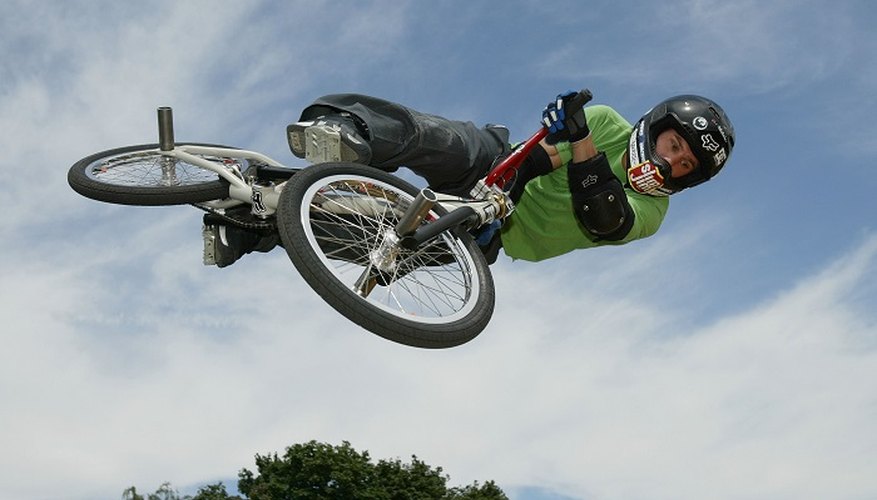BMX ramps are jumps and structures that allow riders to soar through the air to perform various death-defying tricks and stunts. There are several different shapes, sizes and types of BMX ramps, many of which are also used by skateboarders and other action sports enthusiasts. Not all ramps have to be built or constructed, because seasoned BMX riders may find similar substitutes in town parks or shopping centres. A BMX ramp is only limited by the imagination, as any solid surface with a slope can be turned into a jump.
Kicker launch ramp
A kicker is a launch ramp or take-off ramp. It is usually built with a curved incline and a lip, which is the top portion of the ramp that gives the rider the needed kick to achieve more air. Kicker ramps can range from all sizes and lengths, anywhere from 30 cm high to at least 2.5 metres high. Some small kicker ramps are made portable and can be purchased fully built at sport shops.
- A kicker is a launch ramp or take-off ramp.
- Some small kicker ramps are made portable and can be purchased fully built at sport shops.
Double launch/landing ramp
A double is a combination of a launch ramp and a landing ramp, with a gap between the two. While the launch ramp usually consists of a curved transition, or surface, with a lip, the landing ramp is usually straight with a less steep decline. Some doubles may also be referred to as step-ups, where the landing ramp is built higher than the launch ramp, or step-downs, where the launch ramp is higher.
Box jump
A box jump, sometimes called a tabletop, is basically a double where the gap between the launch ramp and landing ramp is replaced by a flat, solid surface equal to the ramps' height. Box jumps, unlike doubles, do not require riders to soar in the air from take-off to landing. Box jumps can also be transformed into fun boxes, which may have ramps on all sides and incorporate rails and grind boxes.
Quarter-pipe
A quarter-pipe is essentially a 1/4 section of a full circular pipe. The ramp's curved transition usually becomes inverted until it meets the coping, which is often a metal rail that separates the transition from the deck, or the top flat surface of the ramp. When jumping a quarter-pipe, a rider must rotate 180 degrees in the air for a forward landing. This common ramp, in addition to getting air and performing tricks, is also used to gain and maintain speed. The versatile ramp allows for air tricks, coping tricks and deck tricks.
- A quarter-pipe is essentially a 1/4 section of a full circular pipe.
- This common ramp, in addition to getting air and performing tricks, is also used to gain and maintain speed.
Half-pipe or vert
Two quarter-pipes placed opposite one another with a flat area in between constitutes a half-pipe. Also called a vert ramp, it is typically the largest of all BMX ramps. It can range from 1 to 1.5 metres up to at least 5 metres high. A half-pipe is the only common BMX ramp that offers consistent speed and flow all in one ramp.
- Two quarter-pipes placed opposite one another with a flat area in between constitutes a half-pipe.
- Also called a vert ramp, it is typically the largest of all BMX ramps.
Spine
The spine ramp is basically two quarter-pipes placed back to back, usually with the deck area shortened or completely removed. A spine is made to gain height rather than distance, and both sides interchangeably serve as the launch and landing ramps. When jumping a spine, a rider is shot up into the air and must force the front end downward for a smooth landing.
Hip jump
A hip jump is a ramp where the landing is to the side of the take-off, meaning a rider must turn 90 degrees while in the air in order to land front wheel first. Hips are most often found along the edges or corners of other ramps that join together at skateparks.
Dirt jumps
BMX dirt jumps are built by piling and shaping mounds of dirt into various shapes and sizes. They typically consist of a take-off and a landing ramp, much like other types of BMX ramps. Common dirt jumps include tabletops, doubles, hips and berms, which are curved banks used for fast-speed turns. Dirt jumping possibilities can stretch beyond those of other ramps in that they can form rhythm trails, which are series of multiple dirt jumps in a row.
- BMX dirt jumps are built by piling and shaping mounds of dirt into various shapes and sizes.
- Common dirt jumps include tabletops, doubles, hips and berms, which are curved banks used for fast-speed turns.
Warning
Building different BMX ramps may require several building materials and a lot of hard work. Know your limits and get comfortable simply jumping a particular ramp before attempting any difficult tricks. Always wear the appropriate protective gear when constructing and riding BMX ramps.
